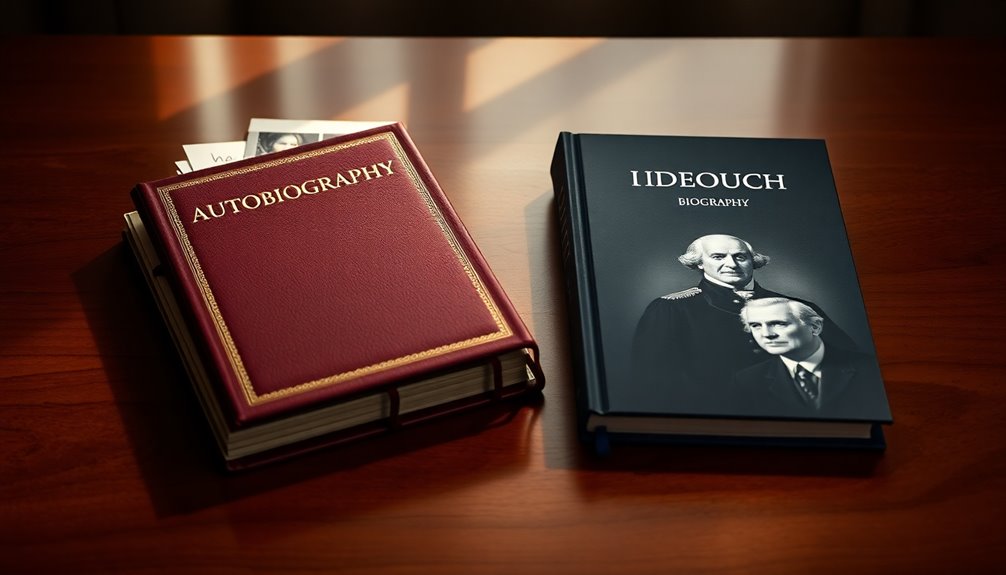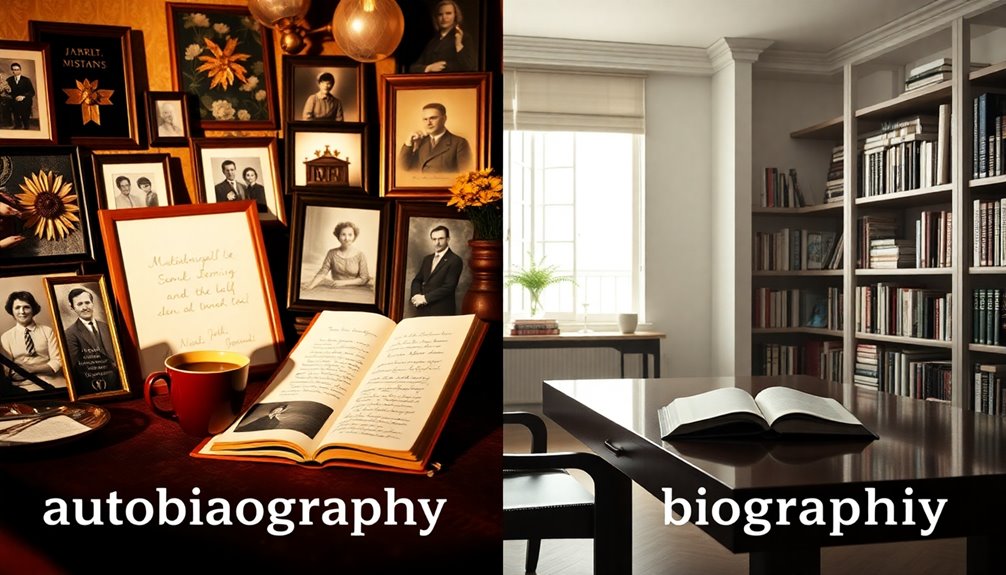An autobiography is written by the subject, giving them control over their personal narrative and emotional insights. You'll find a first-person perspective that invites a closer connection. In contrast, a biography is authored by someone else, focusing on factual accuracy and an objective third-person perspective. This often makes it feel more detached. While autobiographies emphasize the author's personal experiences, biographies present broader historical contexts. If you're curious about how these differences affect emotional engagement and narrative style, you'll discover fascinating insights as you explore further.
Key Takeaways
- Autobiographies are written by the subject, allowing personal expression, while biographies are authored by external writers, focusing on factual accuracy.
- Autobiographies use a first-person perspective, creating intimacy, whereas biographies employ a third-person perspective for an objective tone.
- Biographies emphasize objective narratives backed by research, while autobiographies focus on subjective narratives shaped by the author's memories.
- The tone in autobiographies is emotional and personal, inviting deeper reader engagement, while biographies maintain an objective tone that may feel distant.
- Memoirs differ from both, focusing on specific events and themes in the author's life, utilizing a first-person perspective for emotional storytelling.
Authorship Distinctions

While both autobiographies and biographies tell the stories of individuals, their authorship reveals key differences between the two genres. An autobiography is crafted by the subject themselves, granting them complete control over the narrative. You'll find that it's often shaped by personal experiences, memories, and reflections. Sometimes, authors enlist ghostwriters to help articulate their stories, but the essence remains theirs.
In contrast, biographies are penned by external authors, who may or may not have permission from the subject. These writers often collaborate with various experts and researchers, pulling from interviews, documents, and other external materials to create a thorough account. The meticulous nature of biography writing involves rigorous fact-checking and verification, drawing on public records and archival data. Often, this results in a narrative that is a chronological account of the individual's life events.
Because biographies rely on multiple sources, they can provide a broader cultural and historical context that autobiographies may lack. This distinction in authorship not only affects the narrative style but also shapes the reader's experience, making each genre unique in its own right. Understanding these differences enhances your appreciation of the stories being told.
Perspective Differences

When you compare autobiographies and biographies, you'll notice a clear distinction in narrative voice. Autobiographies offer personal insights straight from the author, while biographies provide an external perspective shaped by research and interviews. This difference affects how you connect with the story and the emotions conveyed. Additionally, autobiographies focus on personal experiences, allowing the author to share their unique journey and reflections directly with the reader.
Narrative Voice Distinction
Narrative voice sets autobiographies apart from biographies, as it fundamentally shapes how you perceive each story. In a biography, the narrative is written in the third person, utilizing an objective tone. You'll notice the author refers to the subject using pronouns like "he" or "she," creating a sense of detachment. This objectivity is essential, as it aims to provide a balanced and factual account of the subject's life.
On the other hand, autobiographies are crafted in the first person, filled with personal pronouns like "I" and "me." This approach allows the author to share their thoughts, experiences, and emotions directly, giving you an intimate glimpse into their life. The narrative often feels more emotional and personal, making it easier for you to connect with the author's journey. Additionally, autobiographies focus on personal experiences, further enhancing the subjective nature of the storytelling.
Ultimately, the distinction in narrative voice affects how you engage with each type of story. Biographies present an external viewpoint, while autobiographies offer a first-hand account. This difference highlights the varying levels of detail and focus, guiding your understanding of the subject's life and experiences in unique ways.
Personal vs. External Insight
A key distinction between autobiographies and biographies lies in the insights they provide. When you read an autobiography, you're diving into the author's personal perspective. You get firsthand accounts of their life, filled with their thoughts, feelings, and reflections. This intimate narrative allows you to connect deeply with the author's experiences, revealing their motivations and emotional landscape. It's all about their subjective journey, shaped by personal memories and interpretations.
On the other hand, biographies present an external viewpoint. The author, often a third party, aims for objectivity and balance. They compile information from various sources, like interviews and historical records, to paint a factual picture of the subject's life. This approach maintains an objective tone, steering clear of personal bias or emotional involvement. Biographies require extensive research to ensure accuracy, which further emphasizes their factual nature.
While autobiographies offer a nuanced understanding of the author's inner life, biographies analyze the subject's character based on external evidence. Ultimately, your choice between the two depends on whether you seek personal insight or a researched overview of someone's life.
Objective Vs Subjective Narratives

When you think about objective and subjective narratives, you'll notice that they shape biographies and autobiographies differently. Objectivity focuses on factual accuracy and external research, while subjectivity highlights personal experiences and emotions. This distinction is essential, as bias can influence how a story is told and perceived. In biographies, extensive research is crucial for ensuring accuracy and credibility, contrasting with the personal memory reliance found in autobiographies.
Definition of Objectivity
In exploring the difference between objective and subjective narratives, it's vital to understand how each approach shapes the portrayal of a person's life. Objective narratives, typically found in biographies, are crafted by someone other than the subject. They aim to provide a factual, third-person perspective that emphasizes accuracy and historical context. These narratives cover the subject's entire life, including their birthplace, education, work history, and relationships, while maintaining a formal tone.
When you read an objective biography, you see an all-encompassing view of the individual's achievements and their impact on society, all derived from meticulous research and various sources. Unlike autobiographies, objective narratives don't investigate the subject's personal thoughts or emotions, offering a broader perspective free from personal biases. This enhances credibility, as the biographer's thorough fact-checking guarantees reliability. However, the emotional depth often found in autobiographies may be lacking in objective accounts. It's important to remember that even objective narratives can be influenced by the biographer's perspective and choice of sources, impacting the overall portrayal of the life being chronicled. Additionally, the reliance on primary sources in biographies further strengthens their factual basis and authenticity.
Subjectivity and Personal Experience
While autobiographies explore personal experiences and emotions, biographies maintain a more detached stance, offering a thorough overview of a subject's life. In an autobiography, you write from a first-person perspective, allowing your thoughts and feelings to shine through. This inherently subjective approach reflects your unique interpretation of events, creating an intimate connection with readers. You have complete control over how your story unfolds, often focusing on specific themes or periods that resonate deeply with you.
In contrast, biographies take a third-person perspective, aiming for objectivity. They present a balanced, factual account of the subject's life, relying on external research and multiple sources. This external viewpoint allows biographies to cover various aspects of a subject's life, including personal, professional, and public dimensions, while maintaining an objective tone that avoids personal bias. Writing a biography often involves thorough research to ensure accuracy and depth of understanding.
The subjective nature of autobiographies provides a richer, more emotional experience, as you share personal anecdotes and reflections that might not make it into a biography. Ultimately, the difference in narrative style impacts how readers connect with your story versus that of another person, shaping their overall experience of the text.
Bias in Narratives
Bias in narratives greatly influences how stories are told and perceived. In biographies, you encounter an objective narrative crafted by external authors. They provide a balanced view, relying on extensive research and various sources to paint a factual picture of the subject's life. You'll find that the tone is neutral, aimed at informing rather than expressing personal feelings.
On the other hand, autobiographies offer a subjective narrative, where the subject shares their own experiences and emotions. This first-person perspective allows you to connect intimately with the author's inner world, yet it can introduce personal biases.
Here's a quick comparison:
| Aspect | Biography | Autobiography |
|---|---|---|
| Authorship | External author | Subject writes their own story |
| Perspective | Third-person | First-person |
| Tone | Objective | Emotional and personal |
| Research Method | Extensive external research | Personal experiences |
| Factuality | Focuses on factual accuracy | May include subjective views |
Understanding these differences helps you appreciate how bias shapes the narratives you read.
Tone Variations

Understanding the tone variations between biographies and autobiographies can really enhance your reading experience. In biographies, you'll find an objective tone that avoids personal bias and emotional involvement. The narrative style remains formal and detached, focusing on providing a balanced and factual account of the subject's life. This approach aims to give you a thorough and accurate portrayal, allowing for a deeper understanding of the individual. Biographies can vary in scope, covering either individual experiences or specific groups' lives in detail.
On the other hand, autobiographies exhibit a more emotional and personal tone. Here, the author shares their subjective experiences, thoughts, and feelings, creating an intimate narrative that pulls you into their world. The first-person perspective allows for greater emotional depth, making it easier for you to connect with the author's journey.
This difference in tone greatly impacts your engagement as a reader. Biographies cater to those seeking factual information, while autobiographies appeal to those looking for personal connections. Ultimately, the objective tone of biographies helps you grasp the subject's life thoroughly, whereas the subjective tone of autobiographies invites you to empathize with the author's unique experiences. Understanding these variations can help you choose the right narrative for your reading preferences.
Research Methods Comparison

Research methods for biographies and autobiographies vary considerably, reflecting the different perspectives and goals of each narrative form. When you're writing a biography, you'll gather information from a range of external sources, like interviews, letters, and archival records. You'll likely consult friends and acquaintances of the subject to guarantee a well-rounded portrayal. This process involves meticulous fact-checking and cross-referencing to maintain objectivity and accuracy.
In contrast, when you're crafting an autobiography, the focus shifts to your personal memories and experiences. Your reflections, diaries, and introspections form the backbone of the narrative. While you might revisit significant events for deeper insight, you won't rely on external verification to the same extent as a biographer.
In terms of verification, biographies demand strict fact-checking, while autobiographies prioritize personal perspective. As a biographer, you aim for an unbiased narrative, whereas as an autobiographer, your emotions and personal viewpoint shape the story. Ultimately, these differing research methods highlight the unique approach each form takes to tell a life story.
Scope and Coverage

When examining biographies and autobiographies, the scope and coverage of each narrative form reveal significant differences. Biographies provide a thorough life account, covering the subject's entire life from birth to death. You'll find details about their birthplace, education, work history, and relationships, all situated within a broader historical or social context. This extensive approach often highlights significant milestones and achievements, ensuring a balanced and factual portrayal.
In contrast, autobiographies focus on a more personal and intimate narrative. They explore the author's own life, offering insights into their thoughts, feelings, and reflections on life events. While autobiographies may begin in early childhood, they often take a selective focus on specific periods or themes, allowing for a more intimate exploration of experiences.
When it comes to objectivity, biographies maintain a detached tone, relying on multiple sources to present an accurate account. Autobiographies, however, reflect the author's subjective perspective, which can introduce bias. Ultimately, biographies aim for a broad audience appeal, while autobiographies cater to those seeking a deeper connection with the author's personal journey.
Emotional Engagement

Emotional engagement plays a pivotal role in how we connect with stories, especially when comparing biographies and autobiographies. In biographies, the objective tone keeps the focus on facts, providing a balanced view of the subject's life without personal bias. You'll find that these narratives often lack the emotional depth that you might crave. On the other hand, autobiographies shine in this area by offering a more subjective and emotional tone. The author shares their thoughts and feelings, creating an intimate connection that draws you in.
When you read an autobiography, you're experiencing life through the author's eyes, which enhances your emotional connection. The first-person narrative immerses you in the author's journey, making it feel personal and relatable. In contrast, biographies tend to maintain a third-person perspective, which can feel distant. The emotional involvement of the autobiographer enriches the narrative, allowing you to explore deeper meanings and reflections on life experiences.
Ultimately, while biographies inform, autobiographies engage your emotions, making them resonate on a more personal level. This emotional engagement is what often makes autobiographies a more compelling read for many.
Bias in Narratives

While both biographies and autobiographies tell stories of individuals, they do so through distinctly different lenses that can introduce various biases. Biographies aim for objectivity, presenting a balanced and factual account. They rely on extensive research, incorporating multiple sources to provide a thorough portrayal of the subject. This external perspective helps maintain detachment, focusing on accuracy and avoiding personal bias.
In contrast, autobiographies are inherently subjective. They reflect the author's personal perspective, influenced by their memories and emotions. The narrative is based on the author's experiences, often interwoven with personal opinions and feelings. By using a first-person perspective, autobiographers invite you into their world, but this can lead to a narrower view, shaped by their unique interpretations.
This difference in narrative control also affects tone and audience engagement. Biographies maintain an objective tone to cater to a broad audience, while autobiographies exhibit a personal tone that seeks to forge a deeper connection with readers. Understanding these biases is vital, as they shape how you perceive the lives and experiences of the individuals being portrayed.
Memoirs: A Separate Genre

Memoirs offer a unique lens into an author's life, capturing specific moments or experiences that shape their identity. Unlike autobiographies that chronicle an entire life, memoirs zoom in on particular events or periods, emphasizing the author's feelings and emotions rather than strict facts. You'll notice they're always written in the first person, making the narrative deeply personal and reflective.
Memoirs can take various forms, such as personal, travel, cultural, or historical, each focusing on unique themes and experiences. While autobiographies typically follow a chronological order, memoirs can be thematic and non-linear, allowing for more creative storytelling. This flexibility means you might encounter vivid descriptions and insightful reflections that draw you into the author's memories. Additionally, memoirs often blend personal storytelling with historical context, enriching the narrative and providing depth.
The essence of memoirs lies in their compelling story arcs, which guide you through the author's journey. They're not just about events; they explore the impact those moments had on the author's life. Overall, memoirs invite you to connect with the author on a personal level, providing a rich exploration of identity and experience that sets them apart from traditional autobiographies.
Frequently Asked Questions
Can Autobiographies Include Fictional Elements or Embellishments?
An autobiography's like a mirror reflecting your truth; it can't include fictional elements or embellishments. It's your story, shaped by personal experiences and memories, aiming for authenticity rather than creative storytelling.
Are Biographies Typically More Popular Than Autobiographies?
Yes, biographies are typically more popular than autobiographies. They appeal to a broader audience, often featuring well-known figures, and attract readers with their objective narratives, extensive research, and cultural relevance, driving higher sales and readership.
How Do Cultural Differences Affect Biography and Autobiography Writing?
Cultural differences shape how you write autobiographies and biographies. They influence narrative structure, tone, and content, affecting your focus on community versus individual achievements, personal disclosure, and storytelling traditions, ultimately impacting your audience's perception.
What Are Some Famous Examples of Autobiographies?
Absolutely astonishing autobiographies include Anne Frank's "Diary," Malcolm X's transformative tale, and Nelson Mandela's inspiring journey. Each one captivates and compels, offering you profound insights into their remarkable lives and legacies.
How Does the Publishing Process Differ for Biographies and Autobiographies?
The publishing process for biographies often involves extensive research and interviews, while autobiographies rely more on your personal experiences. You'll also find that autobiographies allow for more creative freedom in storytelling compared to biographies.










